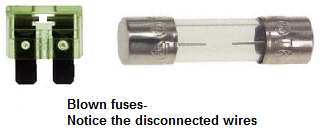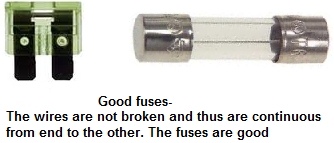How to Test a Fuse

There are 2 tests we can use to check to see a fuse is good or blown.
We can check the fuse visually to see if it's broken or we can do an electrical test on the fuse using a multimeter to
see if it's good or blown.
Visual Test of a Fuse
The first test is to do a visual check of the fuse. If the fuse has a broken or melted connector, it is blown.
The picture below shows 2 blown fuses.

A good fuse does not contain a broken connector and connects from one end of the fuse to the other.
The picture shown below are of 2 good fuses:

Electrical Test of a Fuse

Besides the visual test, the other way to check if a fuse is blown or not is by conducting an electrical test to check for continuity from one end of the fuse to the other.
You do this by taking a multimeter and putting it in continuity mode. You place one probe on one end of the fuse and the other probe on the other end.
If the multimeter beeps, this means that the fuse is continuous and, therefore, the fuse is good. This is because it it continouous, meaning no broken connection.
If the multimeter does not beep and shows a large resistance, this means the fuse is blown.
This is because the connector is not continuous, meaning it's broken and not connected.
If your multimeter does not have a continuity mode, you can check the fuse also with the ohmmmeter of
the multimeter. Place the multimeter on the ohmmeter setting and place the probe leads across the 2 ends of the fuse.
If the reading you get is very low, a few ohms, then the fuse is continuous and, thus, good. If the reading is get
is very high, such as severeal Megohms, the fuse is broken and, thus, bad, and should be replaced.
Related Resources
How Fuses Work
What is a Slow-blow Fuse?
How to Build an Overvoltage Protection Circuit
